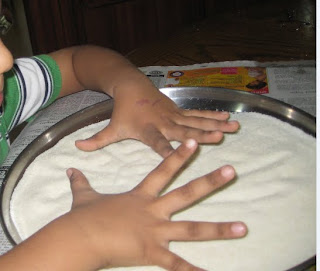Hand Dominance... its relevance
Friday, August 28, 2009

Handedness is an attribute of humans defined by their unequal distribution of fine motor skill between the left and right hands. Some are left handed and some are right handed. However, there are 2 more types of handedness seen, Cross dominance and Ambidextrous. Cross dominance means the child uses one hand for one particular activity and other hand for other specific activity. Ambidextrous is a unique quality that a child can perform a particular skill with both the hands with equal quality. Crossed dominance and ambidextrous is not a problem every time until it affects the function.
Handedness is comprised of hardware (musculoskeletal, strength) and software (neurological), interacting to produce an efficient action. Handedness depends on neurological inhibiting of the recessive hand, so that the dominant hand can develop the precise, corrective, rapid movement without any competition from the non-dominant hand. Generally hand dominance is established at the age of 3 to 4 yrs but as late as 7 yrs. It is important to develop the hand dominance. However most of the child does develop hand dominance spontaneously at age but sometimes children with developmental delay and autism may have problem with it. Parents often have concerns that their children can write from both the hands but not sure.
To develop hand dominance it is important to know the preferred hand of child. Parents and teachers can observe the child in various functional activities. Observe child closely for preference of hand, control, strength and stability. Observe the child in unconscious and sudden or alone without interfering or biasing. It gives a better idea than intentional observation which sometimes becomes biased. Sometimes poor shoulder stability leads the child to keep on shifting the hand which gives a wrong expression of poor hand dominance.
Many activities like horizontal and vertical eight can help in finding the midline orientation and laterality. Bilateral hand activities like scissoring, hammering, tearing the paper, screwing, unliding the bottles, pick up games, lifting heavy objects, push ups and pull ups can be done. Observe the child preference and effort during movements. Once if it gives the idea of hand preferences stimulate that side with graded finger and shoulder exercise.
Posted byNeeti at 10:51 PM
Labels: autism, awareness, disability, knowledge sharing, parenting tips